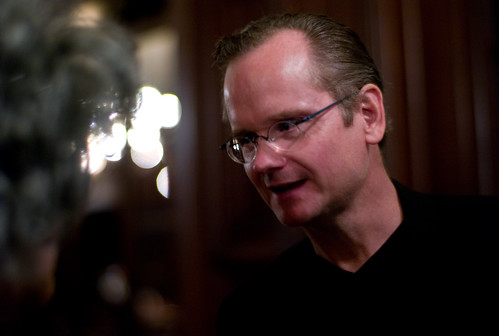“Super” political action committees, or super PACs, have been changing the face of the 2012 election. These PACs often raise more money than the candidates themselves, and are funded by wealthy repeat donors. Restore Our Future, the super PAC associated with Mitt Romney, has raised over 30 million dollars for this election cycle.
It’s in this world that Lawrence Lessig came to the MIT Media Lab to address what he believes is the most important issue to address in America: political corruption, and at its root, that of how political campaigns are funded.
Citing a Rasmussen study, Lessig argues that although 46% of the American public believes that most of Congress is corrupt, the problem is not actually that individual members of Congress are corrupt people who taking corrupt actions, but that the institution as a whole has deteriorated because of the way campaigns are financed — politicians spend between 30% and 70% of their time raising money for their campaigns.
In the age of the super PAC, Lessig points out that less than 200 individual Americans have given 80% of the money donated in an election cycle. Forget the idea of the 1% — Lessig points out that our campaigns are financed by the .0000063%.
Lessig outlines a two part solution to campaign financing. The first involves publicly financing elections, by taking a tax per citizen and giving it back in the form of democracy vouchers that can be used to support a choice of candidates. These candidates must agree to take public financing and only accept donations of up to $100 per person. Such a system would ultimately enable broad participation and also limit the amount any individual can contribute.
Unfortunately, Lessig claims, this would not be enough. Politicians are motivated to use the super PAC model because of the fear that a rival using a super PAC will drop millions of dollars into negative ad campaigns very close to an election. As such, politicians need to obtain what Lessig calls “super PAC insurance.” Politicians try to obtain the favor of potential rich donors even before they might ever need to use their money, allowing the donors to obtain influence with actually giving away any money. Eliminating this arms race would require a constitutional amendment.
So how can this come about? Lessig’s solution comes down to uniting several effective, yet disparate movements such as the Tea Party and Occupy crowds to get such a constitutional amendment passed. Ultimately he wants to unite the leaders of these movements behind a common cause — campaign finance reform.
Is it possible to unite movements of essentially mortal enemies to enact a constitutional amendment? Lessig points out that even if the situation is hopeless, we need to appeal to patriotism and try. He recognizes the use of big data as a tool, and urges the community of hackers and programmers to create an infrastructure that will enable more Americans to participate in democracy. It remains to be seen if enough Americans are motivated to cause the ruckus required to change the constitution. Even though only 11% of Americans have confidence in Congress, too many are used to sitting on the sidelines feeling powerless.
In today’s world, clicks and pageviews are hard currency. In order to amass a movement, Lessig should appeal to those who are well-versed in writing headlines and stirring up sensation. He realizes there is a balance between authenticity and sophistication, but it is unclear if his ideas will travel and have an effect beyond academic circles.


Neha, very strong piece. You’ve offered an excellent balance between covering the important bases of the talk and building a compact, readable piece. I particularly appreciate the use of hyperlinks as footnotes – I think that’s emerging as a best practice in web journalism, and you’ve done a good job of it here. One pushback – we probably need a sentence or two more about Lessig’s past and about the event (time, date) at the lab…